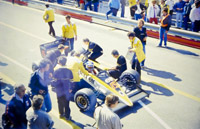MEMORIES / Second dawn of the turbo
Author
- Mattijs Diepraam
Date
- October 8, 2009
Related articles
- 1976 Dutch GP - An unburdened visit to Zandvoort, by Mattijs Diepraam
- 1981 Dutch GP - Ugly teenager surrounded by campsite beauties, by Mattijs Diepraam
- 1983 Dutch GP - Turbo nirvana, by Mattijs Diepraam
Who?Patrick Tambay What?Renault RE40 Where?Zandvoort When?XXXIV Dutch GP (August 25, 1985) |
 |
Why?
Cleaning up their attic, my parents recently rediscovered a box of slides with images of the 1984 and 1985 Dutch GP I took as a teenager. Somehow I knew that I had made them, just as I’d done with these pictures of the 1981 and 1983 races at Zandvoort, but I’d given up on the idea on ever finding them back again. So I was happily surprised when my father shared his discovery with me.
The 1984 gallery
The 1985 gallery
So what do these pictures of the final two Dutch GPs tell us? Apart from the fact that most of them were scandalously overexposed – the film that is, not the objects or people on it – they show a Zandvoort that hasn’t changed much during the last quarter century. It’s almost as if development – which was already lagging behind, and one of the reasons Bernie left the scene – almost arrested since the F1 entourage departed from the paddock for the last time on the morning of Monday August 26, 1985. Some say it’s for the good, others who wished that the Netherlands had kept its Grand Prix will eternally regret that the circuit became some sort of a time capsule. Any which way, it’s a fact that if you’re looking for a genuine 80s track and paddock atmosphere you’ll still be satisfied by visiting Zandvoort.
Another observation by anyone vaguely acquainted with modern-day GPs at glitsy, 21st-century Tilkedromes: F1 events were like club meetings still are today. In the ’84 pictures we see the cars as they were rolled to the parc fermé – and what a parc fermé it was. Barnyards are lined with better-looking sheds than this. The hay sticking to the tyres is further testimony to the agricultural atmosphere. Elio De Angelis (fourth in the race) and Stefan Bellof seem easily approachable, although Stefan – remarkably wearing his works Porsche overalls – didn’t quite seem in the mood for some casual banter, having finished a distant 9th, two laps down on winner Alain Prost, and more importantly some 20-odd behind new team mate Stefan Johansson. That was before the Tyrrell results were scratched from the books altogether, of course. In the ‘85 series, taken during the Sunday morning pitlane walk, he looks as pensive as he did the year before.
The two dominating McLaren-TAGs are seen at the exit of Tarzan where apparently their victory lap was aborted by the marshals. This was some sort of second – and final – dawn of the turbo. The TAG Porsche engine might have been all-conquering in 1984, it was still in its infancy just one year before when Niki Lauda gave it its debut at the very same track. And in the 1985 pictures we see how the Honda engine that was to finally come on song later in the year was still very much prone to failure just a couple of races prior to its first victory at Brands Hatch.
There are still some shocking bits of amateurism – or utter cheapness – contrasting with the amazing turbo technology of the era. In 1984 we see a 5-quid brake light tie-wrapped to the gearbox of an Arrows-BMW A7. It was probably the simplest and therefore best solution to the problem. The local hero is another phenomenon lost to the Grand Prix world now but Huub Rothengatter’s part-seasons in 1984 and ’85 clearly centered around his home race. In ’84 his Spirit was especially painted orange for the occasion, and when he failed to qualify after setting 27th time, the stewards still allowed him to race. He did qualify 26th in 1985, scraping in ahead of the troubled Kenny Acheson’s RAM, some eight seconds – yes, that’s eight seconds – down on pole man Nelson Piquet. But then his Alfa-engined Osella was ancient compared to the Brabham-BMW up front.
The timing equipment seen in the ’85 pictures is looking distinctly old-school as well, as do the pit boards and the modestly sized trophies behind the window of the control tower’s ground floor. It’s not all in the distant past, though. We see the modern space age already revealing itself in the latest monocoque technology pioneered by John Barnard some years before in the McLaren MP4/1. The way the Williams mechanic is marking the ideal pit-entry trajectory by tape is a simple and effective art that is still practised today. But no HANS device attached to Gerhard Berger’s helmet just yet, while the Momo and Personal steering wheels still look like wheels…
So have the times really changed?
